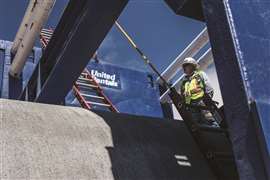5 things we noticed from the United Rentals results
25 April 2025
United Rentals, the world’s largest equipment rental firm, is looking to speciality rentals to drive growth. International Rental News editor, Lewis Tyler, dives into the company’s latest Q1 results to find out more.
 Photo: United Rentals
Photo: United Rentals
While the big news from the first quarter results of United Rentals might be the 7% increase in revenues and record figures for the period, looking deeper they reveal a company continuing to evolve its business model—most notably through its growing emphasis on specialty rentals.
This shift, years in the making, is not only helping to diversify revenue streams but is also positioning the company for long-term growth as customer demands become more complex and specialised.
With that in mind, here are 6 things we noticed from the results and subsequent investors call.
1. Speciality is paying off and United believes it will continue to do so
A big part of United Rentals’ growth strategy in recent years has been its increasing focus on speciality rental.
This segment includes power, heating, ventilation and cooling (HVAC), fluid management, trench safety, reliable onsite services, tools, communications, and industrial blinds.
The emphasis on speciality reflects broader trends in the rental market, where customers are seeking more targeted and technically advanced solutions.
Looking back to 2014, speciality rental made up just 14.5% of United’s total revenue.
Fast forward to today, and that figure has more than doubled to 33%. In fact, the percentage has increased in every year since 2014—except for 2023—highlighting the steady momentum behind this shift.
Mergers and acquisitions have played a key role in expanding the company’s speciality footprint. In 2024, United acquired temporary roadway rental business Yak Access, Yak Mat, and New South Access & Environmental Solutions from Platinum Equity in a $1.1 billion deal.
Yak, which rents wood and composite ground mats primarily to customers in the utilities and construction sectors, added another layer of depth to United’s speciality offering.
Other notable acquisitions include European equipment rental business EQIN and Australia-based Shore Hire, further widening the geographic and service scope of the speciality division.
David C. Scott, senior vice president of United’s speciality division, told IRN last year that the segment has “gained more visibility in the marketplace” as the industry has consolidated.
He added that both speciality and generalist rental businesses have seen strong growth as the market continues to mature and shift from ownership to rental.
Scott said that while speciality rental will remain a key growth driver, general rental continues to be a vital revenue stream. “I believe the definition of speciality is still evolving, which includes more products and services where organisations can create focus,” he said.
“The speciality percentage will continue to grow into the future, but I don’t see it going the other way anytime soon.”
With that in mind, United is planning to launch at least 50 new speciality locations in 2025, following 72 in 2024.
On a recent investor call, CEO Matthew Flannery confirmed that eight new locations had already been completed in the first quarter.
 In 2024 the company acquired Yak, which rents wood and composite ground mats to customers in utilities and construction. (Photo: Yak Mat Facebook)
In 2024 the company acquired Yak, which rents wood and composite ground mats to customers in utilities and construction. (Photo: Yak Mat Facebook)
2. Long-term targets show room for more growth
The results for Q1 of 2025 show no change in its previous outlook for revenues for the full year, with which it expects revenues to be between $15.6 billion to $16.1 billion.
However, looking further ahead the company is aiming to be a $20 billion business by 2028.
That would see its revenues increase some 31% in the next two and a half years.
At the same time, it is targeting revenue for its speciality segment to be around $7 billion by 2028, with adjusted EBITDA of $10 billion.
According to United Rentals, several key factors underpin its confidence in reaching its long-term financial targets.
One of the most significant is the continued long-term growth in non-residential construction.
The company expects to benefit from structural tailwinds tied to North America’s ongoing investment in infrastructure, industrial activity, and the broader trend of re-industrialisation.
The company also points to strong performance across its end markets, driven by its competitive advantages and strategic focus.
United’s “Grow, Deepen, and Expand” framework, along with targeted vertical strategies and selective acquisitions, are helping it capture more opportunities and increase market share in both core and emerging segments.
Margin expansion is another area where United sees room for growth. The company is aiming for adjusted EBITDA flow-through rates of 50–60% across the cycle, supported by a consistent focus on operational efficiency.
Finally, United continues to prioritise fleet productivity and capital efficiency. By maximising returns on invested capital and maintaining a strong free cash flow profile, the company believes it’s well positioned to support continued growth and navigate any future economic headwinds.
3. The impact of tariffs on the industry
“Our 2025 CapEx is fully negotiated and well over 80% of that already has POs [purchase orders] and will not be impacted by tariffs in any way,” said Flannery on an investor call when asked about potential impacts of tariffs.
When asked what would happen if suppliers had to make changes in the future due to tariffs, he said, “We’d probably have to pass it on like what happened post-covid when we all enjoyed some healthy increases.”
“There would be some decisions to make. We’ve got a couple of vendors in every category of equipment that we buy. There’s not a product category that I can think of that doesn’t have a non-tariff impacted partner so there will be a way for us to manage through it and whatever we did have to absorb would be something the whole industry would have to absorb.”
4. Sustainability targets
Speaking broadly, United Rentals has had some sustainability commitments in place for some time, but its latest results go deeper into how the company aims to sharpen its focus.
For example, the company said it aims to reduce the greenhouse gas emissions intensity of its Scope 1, Scope 2, and third-party hauling activities (part of Scope 3) by 35% by 2030, compared to a 2018 baseline.
For reference, in 2023 the company achieved a 25.6% reduction in GHG emissions intensity.
As for its rental fleet, at the time of writing 31% is either hybrid or electric. Although that figure has increased by 4% since 2023, it remains unchanged from comparative figures in 2024.
5. More M&A a possibility
 Photo: United Rentals
Photo: United Rentals
With the H&E Rentals deal called off some time ago, United said that it would focus on a “disciplined and opportunistic” M&A strategy.
And, while perhaps it could be argued that deals such as the acquisition of H&E are few and far between, Flannery said the company believes there are some “chunky deals out there” with “plenty of M&A runway” available in the future.
He said the company had a “pretty robust pipeline before the H&E deal” and that pipeline remains.
He added that it would focus on deals that would add new services or products to its customer base and adding more capacity in speciality.
“We still have wide space and penetration opportunities to support this double-digit growth trend that we’re on. We’re still in the M&A game, we just have to find the right dance partner and make sure it meets our very high bar,” he added.
STAY CONNECTED



Receive the information you need when you need it through our world-leading magazines, newsletters and daily briefings.
CONNECT WITH THE TEAM








